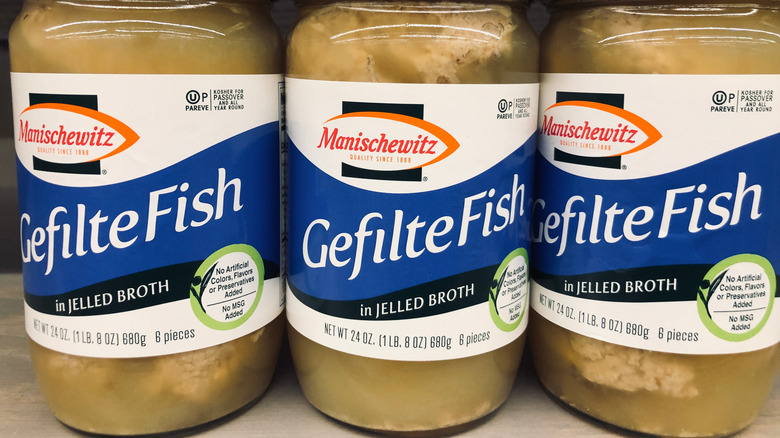What Is Gefilte Fish, And Why Is It Eaten During Passover?
Every culture has its fair share of holidays, and each of these special celebrations or commemorations has its own unique set of traditions associated with it. However, there is one practice that makes its way into nearly every single one of these occasions. On holidays, friends and family often gather together for a meal, which inevitably consists of culturally-specific cuisine.
The histories of certain iconic holiday foods are fascinating. To celebrate the Lunar New Year, chefs in China whip up batches of dumplings as an homage to a legendary doctor who cured a rural village's frostbite outbreak with the steamed, spiced meat snacks. And figgy pudding, familiar to many by way of a popular Christmas ditty, originated when people preserved their meat with sugar and booze.
Jewish culture is no exception to the global tradition of cooking holiday food. One popular Hanukkah food is latkes, or fried potato pancakes. Hamantaschen, a triangular fruit-filled pastry, are classically enjoyed during Purim. During Passover, a Jewish family might dine on a particular whitefish, one which has a rich history as a fixture of the holiday.
The traditional preparation of gefilte fish
If you're out on a fishing trawler, it's unlikely that you'll run into a gefilte fish. That's because the term gefilte refers to the fish's preparation, not its speciation. Gefilte is a Yiddish term that translates to stuffed. The etymology of the dish draws to mind a stuffing-packed Thanksgiving turkey, another traditional holiday dish, but in reality, putting prepared gefilte fish back into its original skin is no longer common practice. Traditional recipes call for pike, carp, and whitefish, or some combination of the three.
Essentially, making gefilte fish entails stripping the fish's meat from its bones and grinding it together with spices and fillers including vegetables, eggs, and breadcrumbs. The resulting mash is then poached and served with a variety of accouterments, mainly grated horseradish or slices of carrot. Gefilte fish in white wine herb broth is one such example of this preparation. The dish has followed Jewish people around the world, and different cultures have developed different styles of gefilte fish — Lithuanian gefilte fish has an extra kick of pepper, while Polish gefilte fish is sweet. In Mexico, you can enjoy a gefilte fish dish that is seasoned with chili peppers and utilizes a base of red snapper in lieu of the traditional carp.
Gefilte fish and dietary restrictions
There are a number of reasons why gefilte fish might be enjoyed during a Passover seder beyond just its taste. The preparation process behind gefilte fish satisfies several stipulations of a kosher diet. On the Sabbath, some Jewish people are religiously prohibited from igniting a heat source, meaning cooked fish is forbidden. Pre-prepared gefilte fish served unheated honors this religious law. Additionally, the laws say that a person cannot remove meat from bones on the Sabbath, which is also avoided by consuming gefilte fish.
Writing for the Jewish Telegraphic Agency, Rachel Ringler notes that the first mention of a stuffed pike dish appeared in "a 700-year-old, non-Jewish, German cookbook." But gefilte fish likely found its way into Jewish kitchens because rabbis during the Middle Ages "considered fish to be the perfect food to kick off a Sabbath or holiday meal, since fish symbolize the coming of the Messiah and fertility."
When European Jews came to America, they brought gefilte fish with them. Tales have been told about bathtubs full of live carp in 1900s New York, swimming in hopeless circles while waiting to be ground into gefilte fish. By the 1950s, advances in food preservation technology saw the mass production of jarred gefilte fish, helping to further solidify the delicacy as a staple of traditional Jewish cuisine. More recently, Brooklyn-based company The Gefilteria has been working to "revolutionize" the dish, crafting it from a combination of whitefish, pike, and steelhead trout for a new generation.


